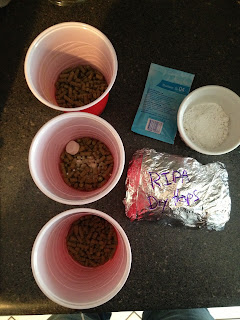Its been awhile since my last post, but I'm happy to report the reason for not publishing content is (hopefully) creating it. I have been brewing every weekend for the past month or so, mostly continuing my experiments with mixed cultures, as well as transitioning into my next homebrewing query, which I will start posting next next month.
I've also been researching and drafting my presentation for the National Homebrewers Conference in June, which will dive into the sour beer production techniques I've shared on this page (and some I haven't). The title of the presentation is Methods of Creating and Maintaining A 'Wild' House Culture. If you're attending the conference, please join me!
A few weeks ago, I took a break from the bugs to focus on a beer for a unique and challenging local competition.
For the past few years Andrew Castner, the Brewmaster for Indiana's two RAM brewpub locations, holds a local homebrew competition. The winner helps Andrew brew his/her beer in RAM's brewery, where it is released as a seasonal. An awards ceremony is held at RAM's downtown location the day of the competition, rewarding all entrants with free samples, giveaways, and an open forum for smack talk.
For the past few years Andrew Castner, the Brewmaster for Indiana's two RAM brewpub locations, holds a local homebrew competition. The winner helps Andrew brew his/her beer in RAM's brewery, where it is released as a seasonal. An awards ceremony is held at RAM's downtown location the day of the competition, rewarding all entrants with free samples, giveaways, and an open forum for smack talk.
I enjoy entering this competition because the guidelines are always unique and challenging. Last year's theme was "Session IPA", which asked brewers to create a flavorful, hoppy, balanced beer with an original gravity below 1.040. Although I didn't win, I learned a lot from brewing the beer and from the judge's comments. Also - the commercial version of the winning entry was delicious.
This year, the challenge is entitled "Rye Not?", and requires a beer brewed with at least 20% rye (and named with a ridiculous "Rye" pun, apparently). Any base style can be used, as long as the original gravity is under 1.060.
Inspired by a recently-released seasonal by 3 Floyds, I concocted a dry, light-colored IPA with a hefty dose of rye malt and piney/citrusy American hops. And a ridiculous, pun-charged name.
I was concerned the slick mouthfeel from the rye will be off-putting in an IPA, either coating the tongue with bitterness or creating a cloying sensation. For the first attempt, I just dumped in 20% rye malt to my somewhat-standard IPA grist bill and hoped for the best. I should have time to re-brew the beer at least once before the entry deadline.
In selecting hops, I wanted to play off the spicy, peppery, arugula/watercress flavors of the rye. I chose Chinook for pine and spice, Amarillo for orange and apricot, Cascade for citrus and grapefruit, and a bit Columbus to reinforce the earthy/dank aromas from Chinook.
"Ryenstone Cowboy" - Brewday: 03/30/13
Batch Size: 5.5gal
Estimated Mash Efficiency: 65%
Est OG = 1.061
Grain:
10 lbs Rahr 2-Row Pale (58.8%)
3.5 lbs Briess Rye Malt (20.6%)
2.5 lbs Weyermann Munich I Malt (14.7%)
1 lbs Simpsons Med Crystal 50-60L (5.9%)
1 lbs Rice Hulls
Mash: 1.00 oz Cascade (5.0%), 1.02 oz Citra (13.9%)
FWH (90): 1.00 oz each Amarillo (8.7%), Cascade
Boil (15): 1.00 oz each Amarillo, Cascade, Chinook (11.8%)
WP (170F): 1.00 oz each Amarillo, Chinook, Columbus
Dry Hop (2-3 days, as fermentation slows): 2.00 oz Amarillo,
1.00 oz each Cascade, Chinook
Water:
9.5 gallons Kroger 5-gal refills, 0.5 gal Kroger Drinking
water
Looking for ~ 300ppm SO4
Mash Salts: 11.0 g CaSO4, 2.8 g CaCl (+ ¼ tsp packed Baking
Soda for pH adjust)
Sparge Salts: 9.0 g CaSO4, 2.3 g CaCl
Mash:
Mashed in with 5.5 gal at 160F – T=149F, pH ~4.9
Added ¼ tsp packed Baking Soda – pH ~ 5.5 (12:15)
Stirred in Mash hops at 12:40
14:00 – started vorlauf
14:05 – Started runoff to kettle (sample tastes nice.
Bitter, and very sweet spiciness from rye, nice hop aroma, not much hop flavor.
No ‘corn-cob’ flavors like in results from last batch)
Sparged with 4.5 gal at 170F
Collected 6.9 gal at 1.050. 58% mash eff.
Low mash efficiency is probably due to a quick sparge runoff. Also, I normally see an efficiency loss (about 5%) when mashing substantial amounts of wheat, so it is feasible that rye has a similar effect.
Low mash efficiency is probably due to a quick sparge runoff. Also, I normally see an efficiency loss (about 5%) when mashing substantial amounts of wheat, so it is feasible that rye has a similar effect.
Boil:
Boiled for 60 min – added hops at times above (and whirlfloc
at 15 min)
SG = 1.064 (18% evap. rate - expected 15.5%)
Cooled to 61F (oops)
Whirlpool for 20 min at 61F.
Transferred to glass carboy – lots of hop matter and trub in fermentor.
Fermentation:
Pitched at 63F: S-04 (rehydrated) and 1 packet 1728
(Scottish Ale)
Shook for ~90 sec to aerate.
Fermentation signs visible within 12 hours.
4/4/13 (evening): Added dry hops. SG = 1.008 (7.4% ABV)
4/7/13 kegged at 20 psi




No comments:
Post a Comment